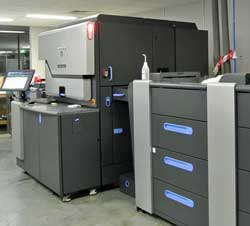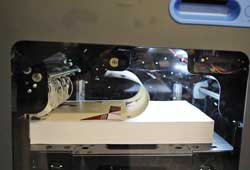The Nulab Group has installed two HP Indigo 7600 digital presses to handle the bulk of its work and will decommission its silver halide printers from June, making it the only high-end pro lab in Australia – and perhaps the world – to entirely abandon traditional AgX photo printing technology.
Nulab managing director Michael Warshall said 90 percent of Nulab’s output was up to 11×14-inch and this was where the Indigo 7600s would be put to work.

It will continue to use Epson wide-format printers for larger size prints, and canvas and metallic orders.
He first saw the 7600s at DRUPA, the international print industry trade exhibition in Germany, and was immediately impressed by the quality of the output, combined with their speed.
‘One 7600 replaces 10 silver halide machines,’ he said. The other factor which appealed was the ability of the Indigos to handle a wide variety of different papers, enabling Nulab and thus its professional photographer customers to expand their range of products.
Nulab is no stranger to Indigo digital printing, installing its first Indigo 5500 six years ago, but the commissioning of the two top-of-the-line Indigo 7600s, at a cost of something around $2 million, is a massive vote of confidence in what HP describes as ‘digital press’ technology.
The Nulab machines are set up for printing in six colours – CYMK plus Light Magenta and Light Cyan. An extra line can be used for a white ink – to print on transparencies or dark coloured substrates – or for a transparent ink for varnishing or raised print effects.
According to the Indigo HP spec sheet, the 7600s print 8-bit images at 812 and 1219dpi. They can handle paper sizes to 13×19-inch, and deliver automated double-sided printing.
Mr Warshall said that compared to silver halide printing the colour gamut is ‘a little shorter on the blue side’ but maintains the difference isn’t discernible when silver halide and Indigo prints are compared side by side, even by experts.
‘No-one can spot the difference when shown comparison prints – it’s really just academic.’
He said the colour gamut from wide-format inkjet is slightly wider than both.
Nulab will use Kodak Endura EP paper, a premium double-sided, photo-quality press paper as it’s main substrate with the Indigo 7600s, and is also trialing some ‘exotic’ substrates from Felix Shoeller (who he says also manufacture Kodak Endura EP) such as metallic papers, oyster pearl and matte.
In addition to the ‘silver-halide like’ quality achievable from the Indigo 7600, Michael nominates its superior archival performance as an advantage.
‘According to Wilhelm, Kodak photo paper on the wall keeps for 19 years and Indigo for 31 years, and laminated for 36 years.’
When not exposed to light, as in a photo book, silver halide images last for 100 years ad Indigo-printed images for 200 years, he said.
He said that the cost of production were about the same and Nulab was not going to change its pricing as a result of the changeover to Indigo printing.

‘This is probably the most exciting thing we’ve done in 42 years,’ said the noted photo industry innovator. ‘We will be developing new products that no-one has ever seen before.
‘Silver halide has been around for 150 years. This is something totally new.’
He will be touring Australia and New Zealand to present the new technology and its capabilities to professional photographers, following attendance at the DScope Asia conference of HP graphic art customers in mid-June.
– Original story published in ProCounter.com.au
But why?
HP’s public relations consultancy, Porter Novelli, issued a press release to support the Nulab Group’s switch to Indigo technology, an indication of the strategic significance the company has placed on the move:
I’d like to introduce you to Nulab Group. If you’re not already familiar with the company, Victoria-based Nulab Group is Australia’s premier professional photographic laboratory. Run by respected photographer Michael Warshall, the company specialises in professional quality printing, including award winning photo books and other personalised photo products.
Nulab Group is making a bold move, replacing the tried, tested and established silver halide technology traditionally used by all photographers with two HP Indigo 7600 Digital Presses, which will enable the company to print high quality photo prints on many different substrates. It will also allow Nulab Group to introduce a number of new techniques to the photo industry, including digital texture effects and raised printing digital watermarks, resulting in an increased range of products and creative effects for customers. This is the first time these techniques have been available to photographers, professional or amateur, in Australia.
Eliminating the need for the plate-related chemicals used in silver halide technology has also helped Nulab Group to reduce its environmental footprint.
‘Silver halide technology, traditionally used for photographic printing, is becoming expensive and damaging to the environment,’ said Michael Warshall, executive director, Nulab Group. ‘Our products are renowned for their high end professional quality, so any technology replacing silver halide had to offer a similarly high image quality. The HP Indigo digital presses produce the same standard of image at higher production rates and many more substrate options to the clients, with no need for chemical processing.’





Be First to Comment